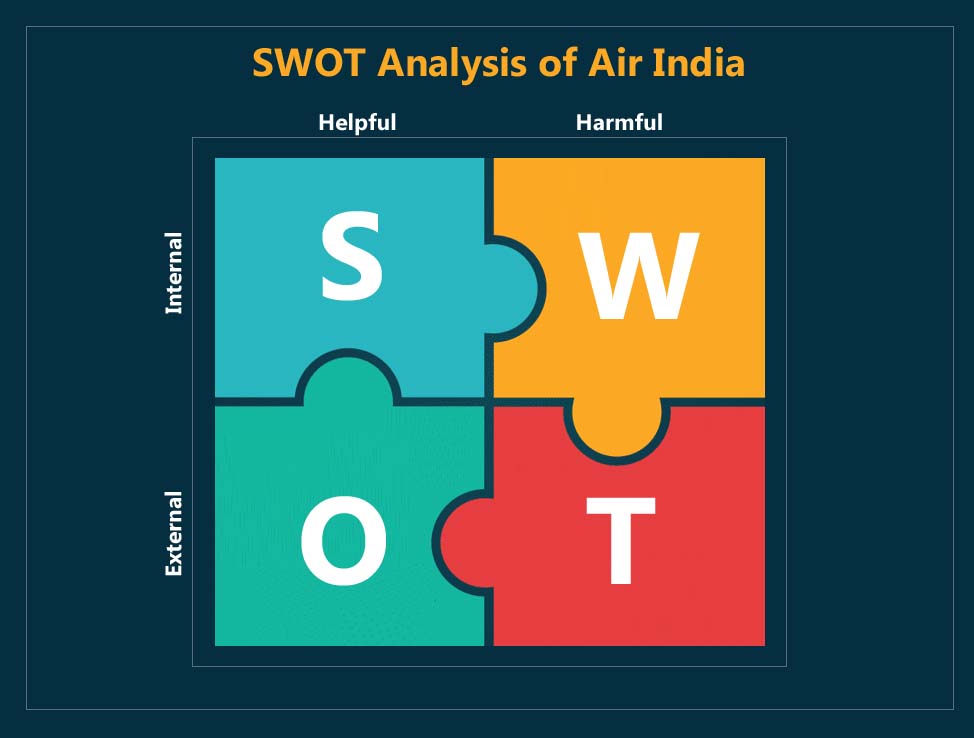The purpose of this comprehensive SWOT analysis of Air India is to analyze Air India’s internal and external environments. It’s about looking at the airline’s strengths and weaknesses. This also seeks to discuss the possibilities that Air India should pursue and the possible threats that it should keep an eye on.

Strength in the SWOT Analysis of Air India – Air India SWOT Analysis
- Air India is one of India’s main providers of flight services. This is India’s flag carrier airline, as well. Indira Gandhi International Airport, New Delhi (India) is the airline’s hub. Air India is known to be a leading service provider.
- Air India has served 101 destinations including 57 domestic destinations. It travels to 33 countries all over the world, spanning four continents. This has a large number of new Airbus and Boeing airplanes. Air India has arrangements for code-sharing with a range of airlines around the world.
- Air India is India’s largest State-owned airline. It enjoys therefore financial assistance from the Indian government. Air India is also known for the quality of its services.
Weakness in the SWOT Analysis of Air India – Air India SWOT Analysis
- Air India is in a financially vulnerable position. Air India is facing financial losses. The airline has in reality made continuous losses and incurred massive losses. In the past decade, the total losses swelled to around 69,575.64 crores. The Indian government has declared a decision to sell the carrier, due to financial problems and some other issues.
- Air India operates through large international and domestic markets, competing with leading world-class giant airlines as well as small local operators. This lack of clarification about the strategic path dilutes its strengths in large measure and confuses its brand within markets.
- Low productivity, low power usage.
- Growing Competitor base and low-cost carrier entry (LCC’s)
- The high-cost structure of the airline and the compulsions to be a member of the public sector are the reasons it suffered a loss and will continue to make losses for a few more quarters.
- Air India operates through large international and domestic markets, competing with leading world-class giant airlines as well as small local operators. This lack of clarification about the strategic path dilutes its strengths in large measure and confuses its brand within markets.
- Low productivity, low power usage.
- Growing Competitor base and low-cost carrier entry (LCC’s)
- The high-cost structure of the airline and the compulsions to be a member of the public sector are the reasons it suffered a loss and will continue to make losses for a few more quarters.
Opportunities in the SWOT Analysis of Air India – Air India SWOT Analysis
- India by population is the second-largest nation in the world. So, imagine just how big the domestic market is for Air India is not difficult. The airline has growth opportunities in the domestic industry.
- The demand for tourism is strong worldwide. Airline industry de-regulation also makes airlines more open to the global skies than ever before. Both the demand for tourism and the deregulation definitely provide prospects for international growth for Air India. Most observers consider the recent decision by the airline to launch its second long-haul route three times a week from Mumbai to London Stansted Airport, a step in the right direction.
- India ‘s airline industry is growing faster and will continue to expand as GDP increases, and it is expected that the trend will continue until the slowdown falls.
- Worldwide deregulations make skies more accessible; it is easier to find consensus on the road. India’s number of international tourists and investors is growing rapidly.
- Complementary industries such as tourism would raise demand for airline services. The strict supervision and safety by the Ministry of Civil Aviation present incentives for restructuring and optimization.
- Customers are more affluent, tend to be less price-conscious, and choose quality service over cost.
- Air India has an opportunity to launch a Low-Cost Carrier.
Threats in the SWOT Analysis of Air India – Air India SWOT Analysis
- The final item to be considered in Air India’s SWOT analysis is a hazard. Air India is facing stiff competition on its foreign routes from some of the world’s biggest airlines. Small local airlines and their price wars are also considered threats to Air India.
- Air India is facing imminent hostile competition from the world’s leading airlines, and domestic-led price wars.
- The Indian Railway Ministry has significantly increased speed and reliability on its medium to long-distance routes, drawing passengers away from air reliability, with rates nearly equal to those of low-cost carriers
If you like This Article Please Like our Facebook Page PROJECTS4MBA
Cite This Work
Referencing Style to cite this article:
[citationic]

